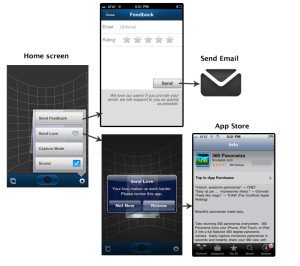Improving Your App Store Rating
Lets face it, 80% of the apps out there are garbage. They either don’t solve a problem well, they were poorly built, or just don’t work at all. These apps deserve bad public ratings and don’t belong anywhere on the app store charts.
Then there’s the other 20% that are backed by passionate designers and developers changing how we interact with technology. People like Mobile Orchard readers 🙂 These apps deserve recognition.
Even great apps get negative feedback, and that’s OK. Feedback is a great thing when we can learn and improve from it. What’s broken is that when someone leaves a negative review in the app store, it scars your app for life, you can’t respond to it, and you can’t learn more about the problem in order to fix it quickly.
Harsh app reviews
Most of the developers I know building great apps tell me how app users are so quick to make a harsh review without much use or thought. I can only imagine how frustrating this is to deal with if you’ve put a lot of time and effort into creating something useful.
This is human nature though. When we’re frustrated with something, we want to vent, and in the heat of the moment we usually say things we don’t mean and without much forethought.
Get feedback coming to you and not the app store
As an app developer you want feedback (especially heated negative feedback) to come directly to you and never find it’s way into the app store.
When the feedback comes to you instead of the app store, you control your destiny:
- You can turn your angry customer into a happy one by promptly responding and supporting them
- You can learn more about the problems and fix them faster
- You receive less negative reviews in the app store
It’s a win/win.
Creating an outlet for customer feedback
One of my personal favorite apps for taking and sharing panoramas, 360 Panorama by Occipital, does a really good job at keeping negative feedback out of the app store while helping disgruntled customers. They have two buttons, “Send Feedback”, and “Send Love”. Send Feedback opens up a screen which looks and feels like a review, but sends an email directly to the developer. Send love takes you to the app store for a review.
As you can see they have quite a good rating, which is well deserved, but it wasn’t always that good.
Crittercism is a handy framework for quickly incorporating a feedback mechanism into your app. Shacked Software recently incorporated this into Flickpad and has reported good results so far. Crittercism loads a support forum where users can submit bugs, ask questions, suggest feedback, and spread the love for your app.
Google+/Hangouts
I was recently chatting with my friend Nick who is one of the developers behind Diptic, a top photo app in the iTunes store, and he mentioned experimenting with Google+ and “hangouts” to field support questions. Great use of modern (and free) tools to improve customer support.
Appirator is a class that you can drop into any iPhone app that will help remind your users to review your app on the App Store. This technique can be effective to remind people to rate your app. Displaying the review reminder after several uses will help ensure that only people who are enjoying your app see the reminder.
Frequently update your app
Not only do updates reset the bar in the iTunes app store to that you can re-establish a good rating, but they (hopefully) improve your app. Fix the bugs and add new features, even minor updates in small increments can have a positive impact.
There is no silver bullet
Achieving a great app store ranking isn’t easy, but with some conscious effort and planning you can maximize your rating and avoid the permanent scaring of harsh reviews.
In recap:
- Create something useful
- Provide an outlet for feedback other than the app store and make it very accessible within your app
- Quickly respond to your customers
- Quickly fix bugs and update your app
- Remind frequent users to rate your app in the app store






